The Common Kingfisher

The Common Kingfisher (Alcedo atthis), is a small bird that nests in holes in sandy banks along rivers. The kingfisher is often associated with good ecosystem health (Banza et al. 2015), as it depends on shallow streams with clear water and sufficient vegetation in order to hunt its prey (Peris & Rodriguez 1996). It is highly territorial (Morgan & Glue 1977), and even though it is not threatened globally, it is classified as Vulnerable in Europe according to IUCN Red List (BirdLife 2015). Reproduction rates for kingfishers are relatively high: They have an extended breeding season, ranging from April to mid-September, during which they often raise two, sometimes even up to four clutches (Morgan & Glue 1977, del Hoyo et al. 2001). With normally seven eggs per clutch, a single breeding pair can produce 21 to 28 chicks per season under ideal conditions (del Hoyo et al. 2001). Despite their high reproduction rate, populations can experience huge fluctuations and sudden declines (Schmidt 2010). Due to the wide range of habitat with various climatic conditions, different factors are supposed to be the main drivers of population sizes: According to Kniprath (1965) and Schmidt & Zuna-Kratky (2011), strong winters can drastically decimate northern kingfisher populations, whereas in Portugal, rivers generally stay ice free in winter and kingfishers even gain weight (Banza et al. 2015). In Spain, populations are decreasing, as strong river pollution affects the breeding success (Vilches et al. 2012), while Cech (2006) reports the restriction of breeding sites and food availability in Czech republic to strongly limit the amount of kingfishers breedings. In Sweden, breedings are limited to the south and along the coast, as winters are cold and long (BirdLife 2015). While rivers are in relatively good condition compared to the rest of Europe, more than 25% is interrupted by dams (Kristensen 2012). Especially in the south, hydro power plants are omnipresent (personal observation), resulting in artificial channels or diminished river beds, and agricultural pressure is high (Kristensen 2012).
Responsible for this page:
Director of undergraduate studies Biology
Last updated:
05/11/17
